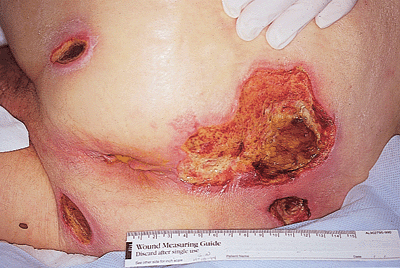Clearly, options for Uraug were limited.
Cleaning the wound and perhaps rotating him, had this occurred to
anyone, would have been about it. Even so, the facts are that ancient
skeletal remains do exist that show people survived for many years
following spinal cord injuries that had left them paraplegic.
Today, treatment options are much better and
certainly effective. Therapy of a decubitus is to prevent further
tissue breakdown and promote healing of the existing wound.
- Patient, family and caregiver
education is critical (click for
patient information form).
- Rotate the patient and/or employ an
anti-decubitus air mattress.
- You still need to be sure there is
no continuous vascular compression.
- Improve tissue blood flow and
oxygenation to the extent possible.

- Local care, such as wound
debridement.
- Keep the ulcer clean and cleared of
necrotic tissue.
- Covering ulcer with a protective
dressing.
- What to use depends on the stage of
the ulcer, infection status etc.
Click here.
- Use of antibiotics, both systemic
and topical may be indicated.
- Provide adequate nutrition,
especially protein, vitamins C and essential amino acids.
- The wound care center of many
hospitals do their own
nutrition evaluation.
- High protein diet, 1.5-2 g/kg of
body weight (click for
patient information form).
- Liquid protein supplements have been
shown to accelerate healing.
- Daily caloric intake at rate of
25-35 kcal/kg. Can be lower for obese patients.
- Frequent small meals if intake is
poor (4-6/day).
- Vitamin and mineral supplements:
Vitamin A, vitamin C (120-240mg), thiamine and zinc (30-60 mg).
- Tube feeding may be necessary
depending on the patient's general condition.
So
what happened to Uraug? |